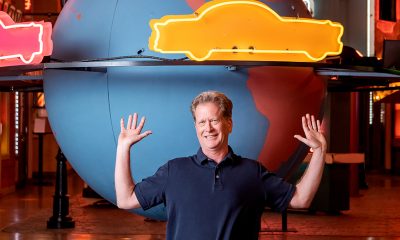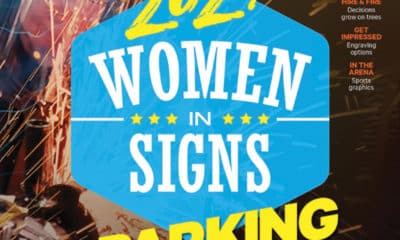A graduate of the Rocky Mountain College of Art & Design, House of Signs (Frisco, CO) proprietor Roger Cox learned about sign design and layout fundamentals from Earl Vehill, one of the Letterhead movement’s “Original Seven” founders.
“He helped us with the sign project that we tried to sell while in college, and, in return, we helped him letter showcards, which sometimes numbered in the dozens,” he recalled. “It was a very inspiring education.”
After graduating, Cox went to work as a ski bum in the Colorado high country, but continued to work on signage. He said his roommates kicked him out because of the fumes that emanated from 1Shot enamels he used to handpaint signs. Looking for another place to set up shop, he found an historic cabin and set up shop in 1989. Since, House of Signs has grown into a 3,000-sq.-ft. shop with five employees – he also operates SignTech, a vinyl-graphics provider – who fabricate routed and carved, HDU monument and building-mounted signage for resort cities throughout the Rocky Mountain state. Some signs have also been sold nationally and worldwide.
“The region’s mining history, the architecture and strict city sign codes are all factors we take into account with our designs,” Cox said. “We think it reflects the local culture with our own creative interpretations. We’ve had tourists from Pennsylvania and Australia see our signs, reach out to us, and order signs for their businesses back home.”
He said most clients have no specific design direction and allow full creative freedom, and noted that helping clients understand the importance of negative space, and that “bigger isn’t always better,” is an important part of meeting clients’ needs.
Cox noted 3-D sign design requires more complexity than flat signage because it entails “more moving parts.” He said, “How much carving and the level of detail required to execute a design should be determined early. Blend materials and finishes to be dimensional and aesthetically pleasing, and mesh them with an integrated bracket or framework.
“Very clear vector design is important before importing design files into 3-D software,” Cox said. “This allows the CNC router to run more smoothly and quickly. However, the files we receive are often of poor quality, and we have to remove dozens of nodes, or redesign it altogether. We ask for .AI or .EPS files, but often receive low-resolution .JPGs. Signs end up 8-12 in. thick, or more, and files are required for each corresponding layer.”
Cox has gained a tremendous asset by hiring Periandros Damoulis, former operator of a signshop in his native Greece, who’s previously been featured in several ST issues. Discouraged by his homeland’s dire economic conditions, “Peris” sought new opportunity in the U.S. He began learning the sign trade when he was 10; a signpainter operated a shop adjacent to his father’s market, and he was immediately entranced with handlettering’s nuances. He opened a shop at age 22 after having served a 10-year apprenticeship and graduating from design school.
“The colorful, rustic designs that House of Signs produces are very similar to my style,” Peris said. “In one of our first design meetings, we began with pencil-and-paper sketches and independently arrived at a very similar design. I immediately understood the importance of chemistry!”
One key example of the shop’s successful, resourceful design involved a building-mounted sign produced for Sunlogic, a Breckenridge, CO sunglass shop. Local codes didn’t allow signs to project 4 ft. beyond the building, or rise 8 ft. above street level. Also, the building’s Victorian architecture provided little mounting surface for the sign.
To solve the customer’s problem, they devised the sign’s support system to partly be concealed under the building’s covered overhang, which reduced its projection footage. And, to preserve the building’s detail, House of Signs developed a bracket that hugged one of the structure’s corbels, and the design went vertical to maximize allowable size.



 News4 days ago
News4 days ago
 Projects2 weeks ago
Projects2 weeks ago
 News2 weeks ago
News2 weeks ago
 How To1 week ago
How To1 week ago
 Real Deal4 days ago
Real Deal4 days ago
 Editor's Note5 days ago
Editor's Note5 days ago
 Photo Gallery2 days ago
Photo Gallery2 days ago
 Product Buying + Technology6 days ago
Product Buying + Technology6 days ago









